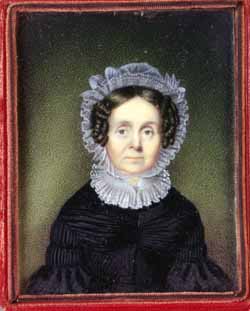Collections Online
Catherine Sargent
To order an image, navigate to the full
display and click "request this image"
on the blue toolbar.
-
Choose an alternate description of this item written for these projects:
- Main description
[ This description is from the project: Witness to America's Past ]
Catherine Sargent was born in Gloucester in 1774, daughter of Epes and Dorcas (Babson) Sargent. She became active in the abolition movement along with her sister Henrietta, and they both became friends of William Lloyd Garrison and his family. She never married and died in her hometown in 1852 at age seventy-eight.1 Garrison wrote in her obituary for the Liberator: "the cause of the stricken slave, and of all identified with him by complexion, has lost one of its truest and best friends. Her sympathies were constantly affected, and her charities actively exercised, in behalf of the poor, the outcast, and the oppressed, without regard to color or race."2
Portrayed in her late sixties, Catherine Sargent sits squarely before the viewer, a sober and dignified woman of the mid-nineteenth century. The treatment of the sitter is highly individualized according to the well-known American desire for a truthful likeness, although Negus's realism is extreme compared to most other painters of her day. Careful attention is paid to the sitter's elaborate white lace day-cap and collar which contrast dramatically with the dark color of her plain dress and the simple stippled background.
Born into a family of painters, miniaturist and crayon artist Caroline Negus worked in Boston in the 1840s and 1850s. Her father, Joel Negus, was a sign painter, surveyor, and schoolmaster in the Connecticut Valley early in the nineteenth century. Her brothers, Joseph and Nathan, worked as itinerant painters in New England and the South. Both, however, died young. As early as 1842 Caroline participated in the first exhibition of the Boston Artist's Association, exhibiting three works, two portraits and a head, after the miniaturist Malbone. She also exhibited at the National Academy and at the Boston Athenaeum. Her drawings of botanical subjects were used for an early series of chromolithographs done in Boston by William Sharp and published in Morris Mattson's medical herbal The American Vegetable Practice of 1841. In 1844 the artist married the noted historian Richard Hildreth of Boston.3
Miniature painting was considered an appropriate artistic expression for women who were often denied more ambitious careers. Like Caroline Negus, Anna Claypoole Peale of the famous Philadelphia family of painters, the Goodridge sisters, Eliza and Sarah, of Massachusetts, and Sarah Frothingham of New York City all had successful careers as miniaturists.4
1. Emma Worcester Sargent and Charles Sprague Sargent. Epes Sargent of Gloucester and His Descendants. Boston, 1923, p.12.
2. The Letters of William Lloyd Garrison. Louis Ruchames, ed. 6 vols. Cambridge, Mass., 1971, 4:210n-211n.
3. George C. Groce and David H. Wallace. The New-York Historical Society's Dictionary of Artists in America, 1564-1860. New Haven, 1957, p.467; Boston Artists' Association. Catalogue of Paintings of The First Exhibition of the Boston Artists' Association, Harding's Gallery. Boston, 1842; Sinclair H. Hitchings. "Fine Art Lithography in Boston: Craftmanship in Color, 1840-1900." In Art & Commerce: American Prints of the Nineteenth Century. Proceedings of a conference held in Boston, May 8-10, 1975, Museum of Fine Arts, Boston. Boston, 1975, pp. 103-104.
4. Robin Bolton-Smith. Portrait Miniatures in the National Museum of American Art. Chicago, 1984, p.9

